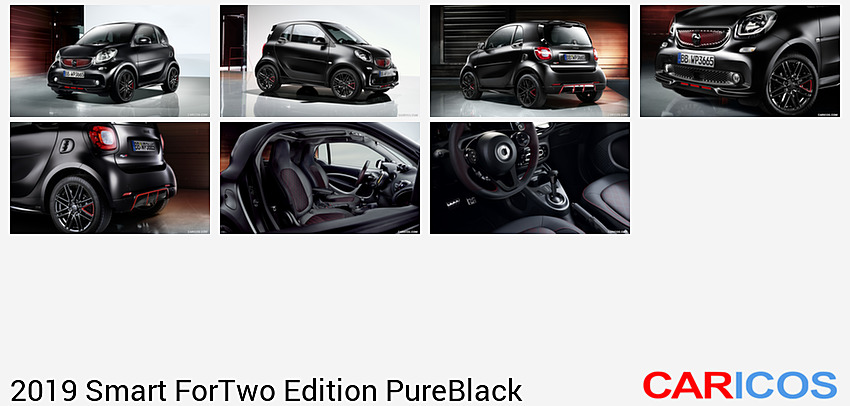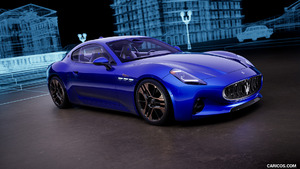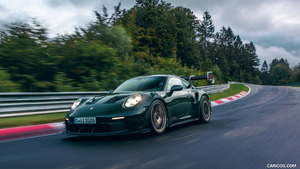Smart ForTwo Edition PureBlack
smart is presenting a particularly stylish variant of the two-seater in Paris in the guise of the "edition pureblack" special model. This limited-edition special model will be available both with the two petrol engines (fuel consumption, combined: 5.0-4.8 l/100 km; CO2 emissions, combined: 114-110 g/km) [4]and as an electric smart EQ fortwo (power consumption, combined: 18.3 -13.2 kWh/100 km; CO2 emissions, combined: 0 g/km)4. The vehicles painted in matt black are set apart by accent trim parts in high-gloss black and highlights in red. The "edition pureblack" will be available for ordering in the coming months, with deliveries set to begin next year.
The special model was inspired by the international design trend to forego colour and combine various shades of black. To set off the black to particularly good effect, the designers have applied red highlights on the inside and outside. These highlights emphasize the matt black paint finish of the bodypanels, the tridion safety cell and most of the detachable parts in velvet black (matt), whose velvety finish contrasts with high-gloss black paintwork featuring on various parts of the vehicle.
The smart logo in the radiator grille features a two-tone black painted finish (high-gloss and matt), while a high-gloss black finish features on the edging of the otherwise matt velvet black side skirt, on the rear diffuser (with red highlights) and on the roof spoiler. Exterior red highlights are also to be found on the hand-finished radiator grille, the front spoiler and the 16-inch black alloy wheels.
 2019 Smart ForTwo Edition PureBlack
2019 Smart ForTwo Edition PureBlack
There is a "edition pureblack" logo on the left at the rear (on the petrol-engine model only) and the smart lettering on the rear is in high-gloss deep black. The body design and development partner for the special model is smart BRABUS.
The interior features black leather in hand-crafted quality on the seats, whose red perforations and topstitching are also to be found on the leather multifunction sports steering wheel, together with a red 12 o'clock marking. The handle of the dark anodised handbrake lever is also covered in black leather. The black dashboard comes in leather look. The shift lever knob is anodised in a dark finish and features a "edition pureblack" logo which also cites the black velour floor mats.
The standard scope of equipment for the "edition pureblack" also includes the Comfort package (height adjustment of the driver's seat, electrically adjustable exterior mirrors and height-adjustable steering column), the Stowage Space package (lockable glove compartment and stowage net on the centre console in the front passenger footwell) and the LED & Sensor package. The latter comprises H4 halogen headlamps with welcome function, integrated daytime driving lights featuring LED fibre-optic technology and LED tail lamps.Other standard features are heated seats, the Cool & Media package with large multitouch display and automatic climate control, the panoramic roof with integrated sunblind and the load compartment cover.
Both petrol-engine versions of the "edition pureblack" come with twinamic as an automatic dual clutch manual transmission with six forward gears.Both clutch actuation and gear changing are fully automatic and enable particularly smooth shifting without any interruption in tractive power. The transmission operates fully automatically. Manual shifting is possible using the selector lever in a separate gate or by means of the shift paddles.
Technical data for the smart fortwo edition pureblack 4:
| smart fortwo twinamic 52 kW | smart fortwo twinamic 66 kW | |
| Number of cylinders/arrangement | 3/in-line | 3/in-line |
| Displacement (cc) | 999 | 898 |
| Rated output (kW/hp) | 52/71 | 66/90 |
| at rpm | 6000 | 5500 |
| Rated torque (Nm) | 91 | 135 |
| at rpm | 2850 | 2500 |
| Combined fuel consumption (l/100 km) | 4.8 | 5.0 |
| Combined CO2 emissions (g/km) | 110 | 114 |
| Efficiency class | D | D |
| Acceleration 0-100 km/h (s) | 15.1 | 11.3 |
| Maximum speed* (km/h) | 151 | 155 |
* Electronically limited.
smart is currently the only car manufacturer worldwide to offer its model range in both combustion-engine and all-electric variants. And smart is the first car brand with its sights set on a systematic changeover from combustion engine to electric drive: since 2017, smart has been selling only electric vehicles in the USA, Canada and Norway. From 2020, it will be marketing only battery-electric cars in Europe, too. The rest of the World is due to follow soon after.
All smart vehicles with electric drive come with a 4.6 kW on-board charger as standard. This provides for fast recharging of a drained battery – in less than 3.5 hours at a wallbox, in under six hours at a domestic wall socket (10-80 percent in each case). The "smart EQ control" app enables convenient remote monitoring of the charging process and remote control of functions such as intelligent charging.
A particularly powerful 22 kW fast charger is optionally available in Europe. This enables the smart fortwo EQ to be charged much more quickly: in less than 40 minutes (10-80 percent) when local conditions permit three-phase charging. Furthermore, smart offers a wallbox as a special item of equipment.
Technical data for the smart EQ fortwo edition pureblack 4:
| smart EQ fortwo | |
| Engine/type | Separately excited three-phase synchronous motor |
| Continuous output (kW) | 41 |
| Max. output (kW) | 60 |
| Max. torque (Nm) | 160 |
| Power consumption, combined (kWh/100 km), 4.6 kW on-board charger | 14.2 |
| Power consumption, combined (kWh/100 km), 22 kW on-board charger | 13.2 |
| Power consumption, combined (kWh/100 km), 22 kW on-board charger at domestic power socket | 18.3 |
| Combined CO2 emissions (g/km) | 0 |
| Efficiency class | A+ |
| Range | 156-157 |
| Acceleration 0-60 km/h (s) | 4.9 |
| Acceleration 0-100 km/h (s) | 11.5 |
| Maximum speed* (km/h) | 130 |
[4] The figures stated were determined according to the prescribed measuring process. In this case, these are the "NEDC CO2 figures" in accordance with Art. 2, no. 1 of Implementing Regulation (EU) 2017/1153. The fuel consumption figures were calculated on the basis of these figures. The power consumption was determined on the basis of Regulation 692/2008/EC.









